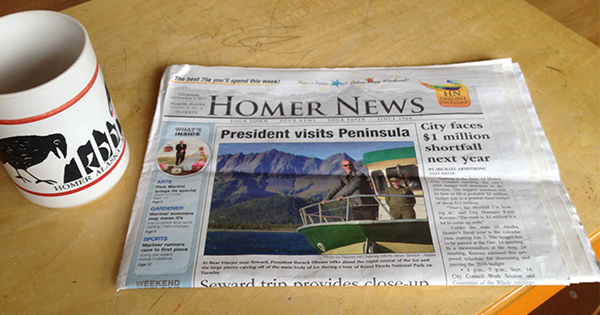
The week President Obama came to Alaska, his photo appeared on the front cover of one of Homer’s two weekly newspapers. This was the first time—as far as the editor who has been there for a decade knows—that a president’s image has ever appeared on the paper’s front page in the publication’s 50-year history. Typically, there’s a photo of the winner of the inaugural five-kilometer Halibut Hustle, or kids hammering together toy boats as part of the annual Wooden Boat Festival, or a group of Coast Guard wives holding a Welcome Home banner for their husbands returning from a four-month deployment.
The paper comes out on Thursdays, and the image showed Obama, two days earlier, gripping the bow rail of a tour boat nosing toward a tidewater glacier in the Kenai Fjords National Park. The Kenai Fjords are part of the Kenai Peninsula—an area about the size of Massachusetts and Connecticut combined—on which I live. Although it would have been a four-hour drive to even catch a glimpse of the president’s motorcade, the fact that he was on the peninsula—on our peninsula—made it seem as though he was in the neighborhood.
And as the pictures of his visit spilled out onto newspapers and websites, I—like Alaskans across the state—saw myself in what he did and where he went. We saw him standing on the same rainy, cobble beaches where we spend so much of our summers. We saw him hiking through the same scrubby alders that scrape our shins—the same alders we have to beat back on our properties—to the kinds of glacier views that draw us out on trails again and again. We saw him holding a freshly caught salmon behind the gill plate, just as we carry our catch. We saw him backlit by a dreary socked-in sky, bare brown bluff at his side: the same kind of wild, workaday Alaskan landscapes we find ourselves in too. We saw him visiting with Dillingham residents and joining kids in a traditional Yupik dance troupe in the middle-school gym; we’ve also danced or played or visited with friends or watched a game or gone to a health fair in our community commons that is the school gym. In images from Air Force One, we saw his face pressed against the windows the same way we try to catch glimpses of Denali and other ragged peaks when we’re flying home from someplace else.
We saw President Obama doing what we do, seeing what we see, learning about the ways that Alaskans live.
Some days, these thousands of miles and four time zones away from where Congress convenes, I feel impossibly far from the machinations of our nation. The federal subsidies that make our lives and life styles possible in Alaska—some measures show the state having the highest per capita federal benefits—are largely invisible, so we don’t see the pipeline of cash that directly connects us to the U.S. Capitol. And what’s news in the rest of the country never seems to be what’s on our minds here. Even our seasons are flip-flopped. In recent years, when snowstorms paralyzed East Coast cities, we were lamenting the patches of green grass that now appear in February, pining for real winter weather.
But Obama’s visit knitted Alaska back into the nation. The week he was here, as 35,000 walruses hauled out on land because the sea ice has retreated so far north, the President pointed at what keeps many of us awake at night. As the fish we seek each summer get smaller, and streams warm beyond the point at which salmon can survive, and winter seems to have disappeared, and the spruce bark beetle might be prepping for another blitz, we need to know that in our country’s chambers of power, someone else thinks of these things too.
Beneath the photo of the president aiming his dark glasses at the glacier was a story about how a bouquet of peonies, grown a few miles away from the center of town, ended up in Obama’s Anchorage hotel room. About the flowers, about the visit, we are immensely proud.

